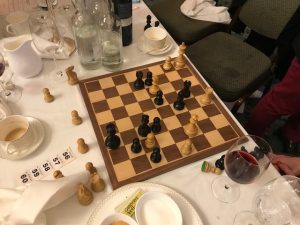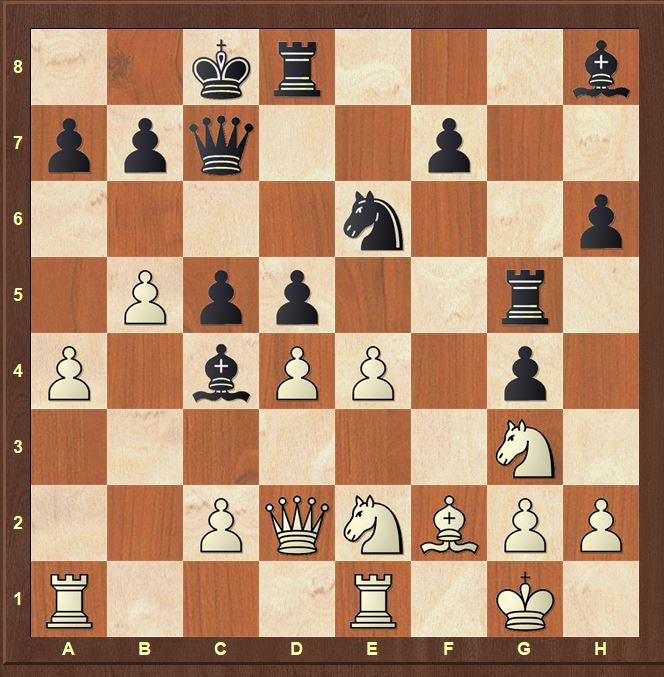The London Classic 2017 was rounded off according to tradition with a lavish closing dinner at Simpson’s-in-the-Strand. As well as beautiful food and wine, guests can take part in a raffle and – more importantly – a silent auction for chess memorabilia (for example a board signed by all participants of the Classic) and events (such as a simul by David Howell) with all proceeds going to the fantastic Chess in Schools and Communities Charity (CSC). This year, a couple of unexpected late items stole the show: a game against AlphaZero (generously offered by Demis Hassabis) and an hour’s snooker coaching with Steve Davis with which a delighted Sergey Karjakin emerged victorious from the bidding war!
However, perhaps the most important tradition of this closing meal is the simultaneous given by the participants of the London Classic. Each of the dinner tables is given a chessboard and the Classic participants – Carlsen, Aronian, Caruana, MVL to name but a few – take it in tums to make moves on each of the tables.
Each table has a mix of playing strengths and there is normally a grandmaster per table to (hopefully) dispense wisdom and help even things up! The game doesn’t always get the fullest attention due to all the distractions of a fine meal with convivial company. However, the tables do enjoy one big advantage: the diversity of the players they face. Most of the top players will come around 3 or 4 times at most during a game. In contrast to a normal game – or a normal simultaneous display – most of the players will have little idea of the flow of the game. They must simply make a single move in the position in front of them and hope that the next player will spot and continue their idea.
It is therefore worth aiming for a complicated, unusual position. In such a position, each top player tends to display his individuality which can lead to a lack of consistency in the execution of plans: one player wants to play on the kingside, the other wants to attack on the queenside, another wants to win a pawn. Seeing the games unfold, it made me realise again that good chess only comes from focus and consistency of purpose. 45 unconnected good moves add up to less than you might imagine!
Our table – comprised of RAC members, their wives, and me as the mercenary GM – was victorious in an entertaining game after surviving some fraught moments in the opening and early middlegame stages.
Classic GMs – Team RAC
1.f4
Played by Levon Aronian with a flourish. The table pointed out to him that Natasha (who was also sitting at the table) had written a Trends book on the Bird’s Opening back in 1998 and was thus likely to be an expert on the opening, but Levon bravely refused to retract his move!
1…e5 2.fxe5 d6
The From Gambit, which is the most dangerous response against 1.f4.
3.Nf3
Unusual – I’d certainly never seen it before – though my database produces 825 games in this line! In principle, it’s a sensible way of avoiding the danger of accepting the gambit with 3.ed Bd6. After 3…de 4.e4, White reaches a reasonably safe King’s Gambit position so we decided to spice things up a little further!
3…g5 4.e6
Adams. 4.exd6 g4 5.dxc7 Qxc7 6.Nd4 Bd6 threatening …Bg3+ looked attractive for a practical game even if the engines much prefer White! Mickey Adams preferred a calmer move that left Black’s pieces in a surprisingly awkward position.
4…Bxe6
4…g4 5.exf7+ Kxf7 6.Nd4 looked tempting for a little while, but actually Black’s king is just as vulnerable as White’s after a quick e3 and Bc4+!
5.e4 Bg7
5…d5 was the only previous game in this line and not an advertisement for Black’s approach! 6.exd5 Bxd5 7.Nc3 Be6 8.d4 h6 9.d5 Bf5 10.Nd4 Bg6 11.Bb5+ Nd7 12.0–0 Ne7 13.Re1 a6 14.d6 cxd6 15.Nd5 axb5 16.Nxb5 Qb8 17.Qd4 Rh7 18.Qe3 Ne5 19.Nf6+ Kd8 20.Qb6+ 1–0 Muzychuk,A Daulyte,D Budva 2003
6.d4 h6
6…g4 7.Ng5 looked very pleasant for White. 6…h6 covers the g5 square and thus (hopefully) turns …g4 into an awkward threat for White
7.Nc3
Played very quickly by Karjakin. We couldn’t resist trying to punish this move by driving the knight back.
7…g4 8.Ng1 Nf6 9.Nge2
Black’s development has hit a wall: his problems are two-fold:
- He cannot develop his queen’s knight to a normal square like c6 or d7 as d5 would win a piece for White. Black’s light-squared bishop – drawn to e6 by Mickey’s clever 4th move – is turning out to be a real problem for Black’s development
- Black’s weakened kingside is not safe enough for Black’s king. Black would really want to castle queenside… but first he needs to develop his queenside. In the coming moves, Black manages to develop his queenside pieces (somewhat awkwardly) and achieves queenside castling.
9…c6 10.Nf4 Qa5 11.Bd3 Nbd7 12.0–0 0–0–0
I was a little worried that d4–d5 might win a piece in a clever way, but I couldn’t see how and neither can the engine! However, with his strong centre and the prospect of storming the Black queenside with his queenside pawns, White is clearly better.
13.Be3 Nb6 14.a3 Nc4
15.Bxc4
15.Bc1 threatening Nxe6 and Bxc4 was worrying me like crazy, and it seems to be as bad as I feared! 15…b5 which I thought was necessary 16.a4 will not go well for long! However, luck was on our side as another of the top players came around, glanced at the board quickly and took on c4. I think it was Karjakin who complained later that he had intended 15.Bc1 when playing 14.a3!
15…Bxc4
Now Black is fighting again. e4 is weak and the knight on f4 – though well-placed – is no longer exerting direct pressure on Black’s position. The light-squared bishop on c4 also helps to slow down any pawn storm from White on the queenside.
16.Re1
Anand
16…Rhe8 17.Qd2 Qc7 18.b3 Ba6 19.Bf2
Carlsen. The position is still delicate for Black due to the number of weaknesses on his kingside. We decided to redeploy the knight to g5 which attacks e4, allows a future …f5 break against the e4 pawn and also shields Black’s weaknesses along the c1–h6 and h4–d8 diagonal. We were relying on a bit of luck for the implementation…
19…Nh7 20.b4
Adams
20…Bc4 21.Nh5 Bh8 22.a4
Mickey was uncharacteristically fuelled by the desire to advance his queenside pawns – I was praying he wouldn’t grab the h6 pawn! 22.Qxh6 was stronger
22…Ng5 23.Qf4
Caruana. Here you start to see how different players can have different ideas about the position. I’m sure that Mickey would just have pushed 23.b5. However Fabiano was our victim this time, and went a different way!
23…Rg8
24.b5
24.Qxg4+ Be6 25.Qe2 Nh3+ followed by …Bg4 was the tactical idea. 23…Rg8 also introduces an ingenious way to regroup Black’s pieces and loosen White’s bind on his kingside.
24…Ne6 25.Qd2 Rg5
Chasing the knight back from g5 and preparing a future …h5–h4
26.Ng3 c5
Once this move appeared on the board, I was sure that Black was doing fine, and Nepo looked pretty impressed too as he came around to make his move. However, Komodo points out an unexpected flaw in Black’s position. To be fair, a lovely French gentleman on our team had pointed out a few times that the bishop on c4 was a little short of squares!
27.Nce2
Nepomniachtchi
27.d5 Nd4 Felt good for Black, but the computer sees differently: 28.Nd1 with Ne3 to follow and the bishop on c4 is trapped! 28…Ne2+ 29.Nxe2 Bxa1 30.Ne3 Bxe2 31.Rxa1 is the beautiful line with the point 31…g3 32.Bxg3 Bh5 33.Nc4 and White has powerful pressure against d6 (33.Bh4 wins back the exchange, but the text is even stronger)
27…d5
Now I thought Black must be clearly better… but the engines still prefer White! All the same, with all the avenues of pressure against White’s position, Black’s position is definitely easier (and more fun!) to play.
28.c3 h5 29.Be3 Rgg8 30.Rab1
Now things take a real turn for the worse. 30.Nxh5 dxe4
30…h4 31.Nf5 dxe4
Securing a very strong square for the bishop on d3
32.Nf4 h3
to free f3 for the Black knight via …hg. 32…Be5 was winning on the spot according to Komodo! 33.Nxe6 fxe6 and White cannot protect the h2 pawn. A real shame because I really liked the idea of 32…h3, trying to secure f3 for Black’s knight or rook by destroying White’s g2 pawn. The choice might have been influenced by all the AlphaZero games I was analysing in which White puts a rook on the 6th supported by a pawn on the 5th rank!
AlphaZero – Stockfish 8
Back to our game now!
33.Nxe6 fxe6 34.Bf4 e5 35.Bg3 Qd7 36.Ne3 Bd3 37.b6 a6
White’s position is collapsing. Black’s plan is to leave the bishop on d3 (it’s worth much more than the rook on b1) and increase the pressure on White’s position with ..hg. …Rdf8 and …Rf3
38.Rbc1 exd4 39.cxd4 Bxd4 40.Kh1 Rdf8 41.Qb4 Qc6 42.Qb3 Rg5
Covering d5 against Nd5 and also removing the rook from the sneaky attack of the queen on b3.At this point, Malcolm Pein came around with Hikaru and Fabiano and said: “This looks awful – you should resign here” Hikaru was quite indignant: “Why should I resign? I’m not lost here. Look at Black’s king” But it was noticeable that he mysteriously disappeared after making his move, leaving Fabiano to defend his assessment!
43.Rcd1
Nakamura
43…hxg2+ 44.Nxg2
Caruana
44…Rf3 45.Ne3
Aronian
45…Bxe3 46.Rxe3 Rxe3 47.Bf4 Re2
and the Black side could experience the once-in-a-lifetime pleasure of graciously accepting the resignation of the World no.2 Levon Aronian!
0–1
And due to popular demand, a few photos from the London Classic dinner!







A very entertaining game. I like Mickey’s e6. Do you have any pictures of this dinner that you can post? Thanks for your very interesting newsletters it’s good to see your analysis and decision making processes. Happy Christmas and may all your pawns be passed! Thanks, Carl and Hannah
Hi Carl, thanks for your comment! I have a few pictures which I will upload. I’m not quite in the David Llada class of chess photography so don’t expect too much! Glad you like the newsletters, and Merry Christmas to you both! Best Wishes, Matthew
enjoyed the explanations… easy to follow